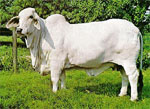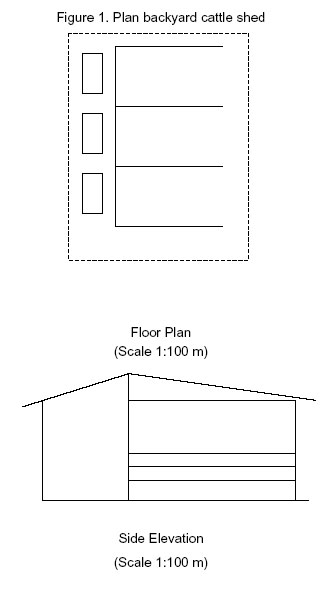
Selecting Feeder Stock
To make profit and produce good meat, consider the following points:
I. Age
Two to three year- old animals need less feed for every unit of weight gain because they digest more efficiently and consume larger volume of feed in proportion to body weight. Younger animals cost less because of lesser weight. They require longer period of feeding and higher feed quality to reach the desired finish. Older feeder stock (4 years and above) need less time in the feedlot and will eat a wider variety of feed and roughage than young stock. If nutritious feed is abundant, younger cattle are generally more economical to fatten. If only roughage and plant by-products are available, older stock are preferable.
2. Sex
Steers (castrated males) are preferred to heifers (unbred females) because they are readily available and easier to manage. Steers also gain weight and grow faster than heifers.
3. Breed
Improved breeds and crossbreds gain weight faster than native animals. Tropical
breeds are more adaptable to local climatic and feed conditions than temperate breeds. Some of the recommended tropical breeds are:
a. Brahman -color is silver gray, some are reddish. This breed is resistant to diseases and can withstand heat better.
b. Ongole or Nellore -color is white. The bulls may have dark gray head, neck and hump. Knees may be black.
c. Indu-Brazil- colors vary from light to silver gray and brownish dark gray to red.
d. Batangas cattle -this is not really a distinct breed of cattle in the Philippines. Cattle fattened in Batangas comes from Mindoro, Masbate and other provinces. The term Batangas beef has become popular because of the good quality cattle produced by the “supak” method of Batangas.
4. Health Condition
A healthy animal is alert and active, has bright eyes, smooth haircoat and moist muzzle. Avoid animals with rough skin and those which are blind and lame. Make sure that the animals have been properly vaccinated against common diseases before bringing them to the feedlot.
When to Buy Stock
Feeder stock usually comes cheap during the dry season (January to April). Country roads are more accessible during these months, making it easy to transport animals from ranch or auction markets to the farm.
Cattle Nutrition
Feed is a key to profitable cattle raising. Cattle need food nutrients for maintenance, growth and production. The animal raiser must formulate feeds based on his animals’ sex, age, weight gain desired and the moisture content of available roughage and feeds. The feed ration should be adjusted to the requirements for fattening cattle based on the availability of feed materials in the locality. Cattle can be fattened on all rough- age rations or on roughage-concentrate ration. Give good quality grass-legume mixture in the form of pasture
herbage. It is best to restrict animal movement at all times, so that it uses less energy and gains weight quickly. The moisture content of feed is important. There is maximum dry matter intake if the ration has only about 34% moisture content. Cattle becomes fatter during summer eating dry grass than during the rainy season when the animals are allowed to eat large amounts of young,
fresh grass. Cattle will consume feed at a rate of about 2.5 percent of its body weight.
The animals need the following nutrients:
a. Dry matter that satisfies the animal ‘s appetite and promotes good digestion;
b. Protein in amounts based on age, sex, body weight and desired productivity;
c. Energy from carbohydrates, fats and excess protein;
d. Essential minerals like salt, calcium and phosphorus. Salt intake increases the water intake of the animals. The daily intake should be about 0.045 kg per 45.45 kg of body weight;
e. Vitamins A, D, and E; and
f. Water is a most important nutrient. Its intake by cattle depends on the temperature,
humidity, moisture content of the roughage, dry or wet feeding, and salt content of feed nutrients.
To estimate the daily feed requirement, young fatteners consume about 3 percent of their body weight in air-dry feed. A fresh grass has about 75% moisture con- tent. Therefore, a 250 kgs. feeder cattle will require 7.5 kgs. of grass with a 12-14% moisture. However, given fresh grass it requires 35 kgs.
Roughage-concentrate ration is the combination of forage or farm by-products and concentrates. Some common concentrates are rice bran, copra meal, ipil-ipil leafmeal and corn by-products, including meat and bone meal and salt. The farm by- products could be utilized as concentrate mixtures and given to cattle at least twice a day.
Recommended Concentrate Mixtures used for Cattle Fattening:
Sample 1
Copra meal 60%
Rice bran 39%
Salt/powdered
Shell 01%
__________
100%
Sample 2
Copra meal 50%
Rice bran 25%
Dried chicken
Manure 24%
Salt/powdered
shell/ground
limestone 01 %
_________
100%
Utilization of Farm By-Products to Cattle Feed
1. Rice Straw -chopped rice straw can be fed to growing-fattening cattle up to 40% of the total ration. If baled or stacked and adequately protected from weather, rice straw can be used as additional source of energy anytime of the year when feed supply is short. It contains 3-4% protein, 0.04-0.08% phosphorus and 0.20- 0.30% calcium.
2. Corn Cobs -(without kernels) can be coarsely ground and fed to cattle up to 45% of total ration. It contains 45% total digestible nutrients and 3% crude protein. Although containing higher crude fiber, it is more digestible than rice straw.
Housing
Proper housing is important in successful cattle fattening operation. Adequately protect animals against the adverse effects of weather when they are raised in relatively small areas. Animals in backyard cattle farms are usually tethered along roadsides and in backyards during the day and confined in a shed or corral at night. The permanent type of housing consisting of GI roofing, timber frames, concrete floor, feed trough and water troughs are used in most farms. The shelter is open-sided and is located near the farmer’s house or under the shade trees. Building height ranges from 1.7 to 1.9 meters while the width varies from 2.1 to 2.7 meters. Each animal can be allocated with 1.5 to 4.5 sq. meters. The plan of the cattle shed is presented in Figure I.
Marketing of Fattened Cattle
Six months after the date of purchase, fattened cattle should weigh approximately 275 to 325 kilograms and be ready for market. Properly handle animals during transport to the market to prevent serious injury or even death. See to it that animals are safely loaded. Avoid steep ramps. Do not lift animals bodily into the truck. A gradually sloping ramp with side railings is advisable. To ensure better footing see to it that animals do not slip and fall during transport. Provide adequate rice straw or rice hall beddings. Remove all protruding objects such as nails and splinters from trucks. Also, check for cracked or missing boards that may injure the animals. Overloading and underloading of trucks cause crippling and bruising of animals. Load them quietly and gently. Pushing or sticking them may cause stress, resulting in weight loss and lower profits. It is better to transport animals in the evening if trucks are not covered.
The market for beef cattle is classified into three groups: consumers, processors and institutional buyers. The last group include hotels, restaurants, burger joints, fastfood chains, cafeterias, supermarkets and hospitals.
COMMON DISEASES OF CATTLE
A. Foot and Mouth Disease (FMD)
Cause : Enterovirus of major strains -A, O & C
Transmission : Direct contact with sick animals excreting the virus; Indirect
transmission by ingestion of contaminated feeds ; Contact with infected products and animal excretion by inhalation.
Symptom : High fever, depression, appearance of vesicles and blisters with
fluid on tongue, gums, udders and inter digital spaces; flowing saliva; animal refuses to eat, becomes lame and refuses to stand. Control Regular FMD vaccination every 6 months in areas where the disease is common
A. Hemorrhagic Septicemia
Cause : Common bacterial disease characterized by hemorrhage (escape of blood from the blood vessels) and septicemia ( a condition manifested by the generalized presence of pathogenic bacteria and the associated poisons in the blood). The disease is rapid in onset and runs a relatively short course.
Transmission :
1) Direct contact with infected animals
2) Ingestion of contaminated feedstuffs
3) By aerosol
Symptoms :
1. Sudden increase in body temperature (41-42°C)
2. Profuse salivation
3. Severe depression
4. Development of hot, painful swelling on the throat, dewlap
5. Difficulty in breathing and
6. Development of signs of pulmonary alimentary involvement
in the later stages.
Control :
1. Isolate and quarantine infected premises.
2. Promptly dispose of carcasses of dead animals by burning
or burying in soil.
3. Segregate sick animals and treat them with antibiotics.
4. Vaccinate apparently healthy and unexposed animals.
5. Sterilize and .disinfect used instruments and equipment.
A. Anthrax
Description : Anthrax is a peracute disease characterized by septicemia and
sudden death with the exudation of tarry blood from the natural body openings. It is a disease virtually of all warm-bloodied animals, including man.
Transmission :
1. Direct Contact -Spread from one animal to another, wherein the bacili are excreted in the urine, feces, saliva and from the natural body openings contaminating the area
2. Ingestion
3. Indirect transmission through airborne via respiratory tract (inhalation) or vector borne through stable files and mosquitoes.
Cause : Caused by large, gram-positive, aerobic spore-forming rod-shaped bacteria known as Bacillus anthracis. In cultures, it forms long chains which, unstained, appear as solid filaments because the square ends of the individual cells fit very closely together. Under low magnification, the margin of the colonies which lie in parallel formation look like locks of hair. It is for this reason that
they are sometimes described as “Medusa head” colonies.
Symptoms :
1. Peracute form (1-2 hours)
a. Sudden death
b. Unclotted blood comes out from the natural openings
2. Acute form (24-48 hours)
a. depression
b. fever
c. difficulty in breathing
d. loss of appetite
e. swelling in hind quarters
f. hemorrhage in many parts of the body
g. death
h. diarrhea stained with unclotted blood
coming from the natural body openings
3. Chronic form (48 hours or more)
a. swelling (ventral muscle, thorax, shoulder)
b. edema
c. difficulty in breathing
d. death
Prevention/Control :
1. Control by immunization
2. Proper disposal of dead animal by burning or deep burial. Quicklime should be used to cover the body before covering with soil. The depth should be 2 meters.
3. Decontamination of all contaminated pens, feeding materials, beddings, etc.
4. Avoid contact with infected animals and contaminated animal byproducts
5. Reduce movement of animals
6. Quarantine infected areas
7. Practice environmental and personal hygiene
8. Control insects and flies
9. Notify the proper authority in case of outbreak.
GENERAL GUIDE FOR CATTLE FARMERS
A. Selection of Feeder Stock
Purchase feeder stock from reliable breeders or select good quality steers from the livestock market.
B. Deworming and Spraying
Have fecal examination conducted to determine proper drugs for deworming. Spray animals to control external parasites such as ticks, lice and flies.
C. Disease Prevention
1. Never buy sick cattle. Make sure the animals are not stressed. Provide good
sanitation.
2. Proper nutrition will help ensure the health of cattle and increase their resistance to diseases. Salt in the diet will help prevent footrot.
3. Don’t mix newly arrived animals with cattle already on feed. New arrivals should receive good quality roughage as a starter ration and then give water three to four hours later.
4. Bathed the animals at least once a week to clean them and to improve their
feed intake.
5. Be alert for signs of illness. Isolate sick animals right away. Deworm and immunize the animals from major infectious diseases. Spray the animals with insecticide to eliminate parasites like ticks and blood sucking fleas. In coordination with the Bureau of Animal Industry (BAI) or the Office of the Provincial Veterinarian, vaccinate against Foot-and-Mouth Disease (FMD),
Hemorrhagic septicemia and other common diseases.
D. Feeding Management Practices
1. Feed animals daily with concentrate one to two kilograms per day during fattening period. Give roughage daily at 3% of body weight if given air dry or 8.75 if given fresh.
2. Give clean water without limit or ad libitum. Provide ordinary table salt about 30-50 grams per head per day.
3. Give the animals fresh, palatable feed and clean water at all times. Reduction of feed intake by 5 percent will reduce weight gain by 10 percent. Do not overstock feeds in the feedbunk since the bottom portion will develop heat and make the feed stale.
4. Mix feed properly. Have at least 15-20 percent roughage in feed to prevent bloat and other digestive disorders.
5. During rainy days, cattle will eat more during the daytime. During summer, they will eat more at night and during the cooler hours. Provide enough feeds during these periods.
6. Digestion will be more efficient if roughage is eaten separately from concentrates. Roughage consumption tends to stimulate saliva secretion up to as much as 80-120 liters per day.
7. Providing l2-14 inches of bunk space per head will allow cattle to eat slowly. This will help increase the rumen’s efficiency thereby facilitating digestion.
8. Schedule manure removal. If allowed to remain with the animals, deep, wet manure will reduce both feed intake and weight gain.
E. Confinement of Animals
Provide proper and adequate space for confinement.
F.. Bathing the Animals
Bathe and wash animals at least once a week to increase feed consumption and promote sanitation.
D. Marketing of Animals
The desired finishing weight of fattened cattleof275-325 kgs. is attained in 180 days fter date of purchase. Visit the “Oksyon” Market nearest your place.
Figure 1. Plan backyard cattle shed
Source: Dept. of Agriculture





Thank you. it really helps me a lot. a very good article.
THANKS .
very useful for new farmer and lot of information in just one article,
Rollie Marri,
very inspiring livelihood project, carry on. a matter of fact, raising beef cattle was my family ancestry livelihood, raised by the hundreds and my own were 56 heads as young as high school by that time, we are so fortunate as big family of ten children finishes our educational career, even my father died at young age of 49 yrs old, financially we were bit stable. i personally encourage you to introduce modern technology cattle raising, like using solar power supply that could pump water for only less than 300 watts submersible, wind turbines as well. planting grasses, especially alpha-alpha high protein for feed. then recycle your waste, into bio-gas and fertilizers, put them in a concrete barns if possible to secure better condition of raising your cattle. secondly we need now to produce more food supply for the demand is great, may God blesses you on your projects.
Im looking for cattle investor to my farm.Located at Lubang occ.Mindoro
we see the the backyard cattle fattening it is ok and we need specific project planning which include the financial, economic,social, environmental aspects.
Hi Rollie,
I’m from panay island(capiz) and its so inspiring to hear your story. I have just started also my hobby project but i have some concern for my existing grass, I think its not enough to have a few. Can you please help me to find humidicula, signal or para grass? Where can I buy seeds of those as well as legumes. I would really appreciate your reply. Thank you and kept on inspiring.
Dan
I and my son have just started cattle raising business at San Guillermo,isabela ,philippines on a 23 ha.rolling land,now fully fenced with available wood and planted in between the wood fences consists of common,giant kx2 ipil-ipil,madre cacao,coconuts. The pasture is divided into 8 paddocks,and divisional fence is planted to different 8 kinds of ligumes.Each paddocks is planted to 9 kinds of nutritious grasess like humicolda,golden timothy,star grass,signal grass,para grass,&etc.We have also planted napier grass about a ha.We have stocked 39 heads of 1-2 years old female upgraded brahman and 2 upgraded bulls.Stocking started Sept.2010.Cattle building is 7mx30m with 3 plastic drums each side to capture rain water for drinking and bathing the animals.A deepwell water system has be established for the the cowboy’s family and as source of quality water for the cattle during the dry season. A salt rack , molasses rice bran has been provided for the cattle.Vaccination of the cattle has been done.Construction of a road from the barrio road to the ranch has been started by us .Establishing the perimeter fence, planting of legumes and grasses,cattle house,water system by 30 labor force from April 1st to end of Sept.this year. Frequent consultation to Dr. Jonathan Nayga of Isabela State University about the project has been availed of every now and then(hopefully more people like him shall be more available for assistance,inspite of his heavy schedules) Cattle fattening and breeding is the aim of the project. Utilization of rice,corn hays & etc shall be done as other source of cattle feed,instead of going to waste . The pasture area is partially planted to giant bamboos as a cooperative effort to reduce climate change,erosion control and as a source of food and income of the barrio folks.
The barrio folks,barangay officials and also the Mayor of the town has given us the encouragements , insperations and support about the success of the project.Hopefully the things so far done may give present & future farmers on how to have contented cows for better nutrition of the filipinos.
THANK YOU FOR YOUR BRIEF DESCRIPTION ON BACK YARD ANIMAL FATTENING.
nice